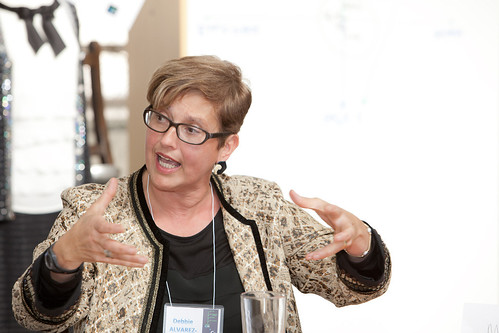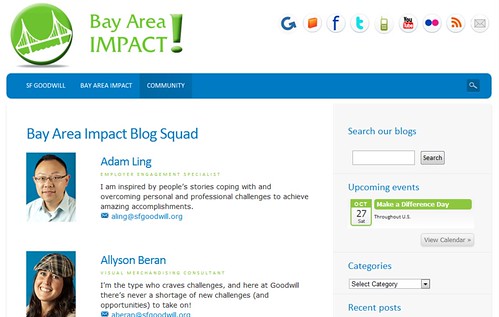
Today, I have the honor of doing a session at The Allstate Foundation‘s 60th Anniversary Executive Summit (hashtag #60summit) where I’ll be talking about leading nonprofits with a network mindset.
Last week, I gave the ending keynote about Mindful or Mind Full Social Media at the Social Media for Nonprofits Silicon Valley Conference. I stayed for the entire, listening to the presentations (Check out summary for tweets, slides, and resource links). SF Goodwill’s CEO, Debbie Alvarez-Rodriguez, gave a compelling talk about her personal journey as a leader of a traditional nonprofit transforming into a networked nonprofit.
Here’s how her talk was described in the program.
Social Media: Getting Leadership Buy-In
Social media presents incredible opportunities for nonprofits, both large and small. Regardless of your budget, this session will leave you in a better position to secure leadership buy-in by getting inside the head of a seasoned nonprofit leader, as well as offer concrete insights on how an established organization is able to use technology to better meet their mission.
When Debbie walked on stage, she carried a shopping bag and the first thing she said, “I’m the CEO of Goodwill, people expect me to have a shopping bag!” She also said that she wasn’t going to use Powerpoint and just speak from the heart. She delivered an engaging and interactive talk and though she didn’t use the phrase, about how she as a CEO of a nonprofit changed to a “Network Mindset” and transformed her organization’s culture from the inside out into a stunning example of a Networked Nonprofit.
Networked nonprofits are open and transparent nonprofits that consider every person and organization in their network an asset for reaching their mission. Nonprofits make that transformation when their leaders embrace a network mindset.
“We all want to be relevant & impactful”-Deborah Alvarez Rodriguez#sm4np
— Social Media 4 NPOs (@SM4Nonprofits) July 26, 2012
To work with a network mindset means embracing an emerging leadership style that is characterized by greater openness, transparency, decentralized decision-making, and collective action. It means operating with an awareness of the networks your organization is embedded in, and listening to and cultivating these networks to achieve the impact you care about.
A network mindset means exercising leadership through active participation. It means sharing by default. It means communicating through a network model, rather than a broadcast model—finding where the conversations are happening and taking part. Putting that into approach into practice is not always easy or fast as Debbie explained in her talk.
She made her point by doing a quick poll of people in the audience. How many of you work for nonprofits that have been around for 10 years or less? And continued to until “How many of you work for nonprofits that have been around for 100 years or more.?” Only a tiny few raised their hands as Debbie mentioned that organizations that have been around for a century or more take time to change their culture.
“If we don’t participate it will be done to us.” regarding social media #SM4NP @dalvarez1 of @sfgoodwill — Jennifer Bullock (@JennyBullock) July 26, 2012
She went on to tell a story about how she first realized that a network mindset was a key to her organization’s future success and being relevant. Her organization was in the middle of some layoffs, not an easy process for any one. Late one night, she received an email from some employees requesting to be part of the decision-making. She thought, “I better call my board chair because he calls me.”
As they were talking, she realized, “They could have put it on Facebook.” This could have created a public relations nightmare (It’s happened in the orchestra world when the Detroit Symphony musicians went on strike and used social media to air their concerns. Instead, these Goodwill employees went to their CEO.
Today’s expectations for organizational involvement in decision-making are higher than they were just 5 years ago. #sm4np
— Karen Brown (@KarenRedRover) July 26, 2012
This lead them to really examine how to effect culture change. As Debbie says, it wasn’t about just using the tools and platforms like Facebook and Twitter – even for herself as the CEO or her organization. That it required a shift from “pushing to engaging.” To make her point, she opened her shopping back and made people take party hats. She said, I didn’t engage you, I just shoved a hat at you. Next, she started tossing balls at people in the audience. Saying, this is more engaging. We are interacting, we are paying attention to each other, having a conversation. This subtle shift was applied to their social media and communications strategy.
Stop pushing and leave time for interaction. Social media is about pulling (attracting) and listening. @dalvarez1 CEO of @sfgoodwill#sm4np
— Thea Smith Nilsson (@theasa2) July 26, 2012
But they realized it was just about an integrated social media strategy and engagement program, it was a strategic redesign of their entire organization from the inside out. he went on to talk about their successes, but did point out that it required work and a good consultant (JD Lasica)

One of the things they did early was to take an inventory of their team members’ skills to discover who was good at the various required skills writing, photography, and video as well as social media savvy. At SF Goodwill they created a Blog Squad to kick things off.

Once established, this became one of many platforms for them to engage their community and share control.
#sm4np Take Away: To thrive, established nonprofits need to embrace change, risk losing control in order to build a more robust community. @dalvarez1
— Beth Kanter (@kanter) July 26, 2012
Has your nonprofit’s leadership adopted a network mindset? What has been impact on your organization from the inside or outside?
